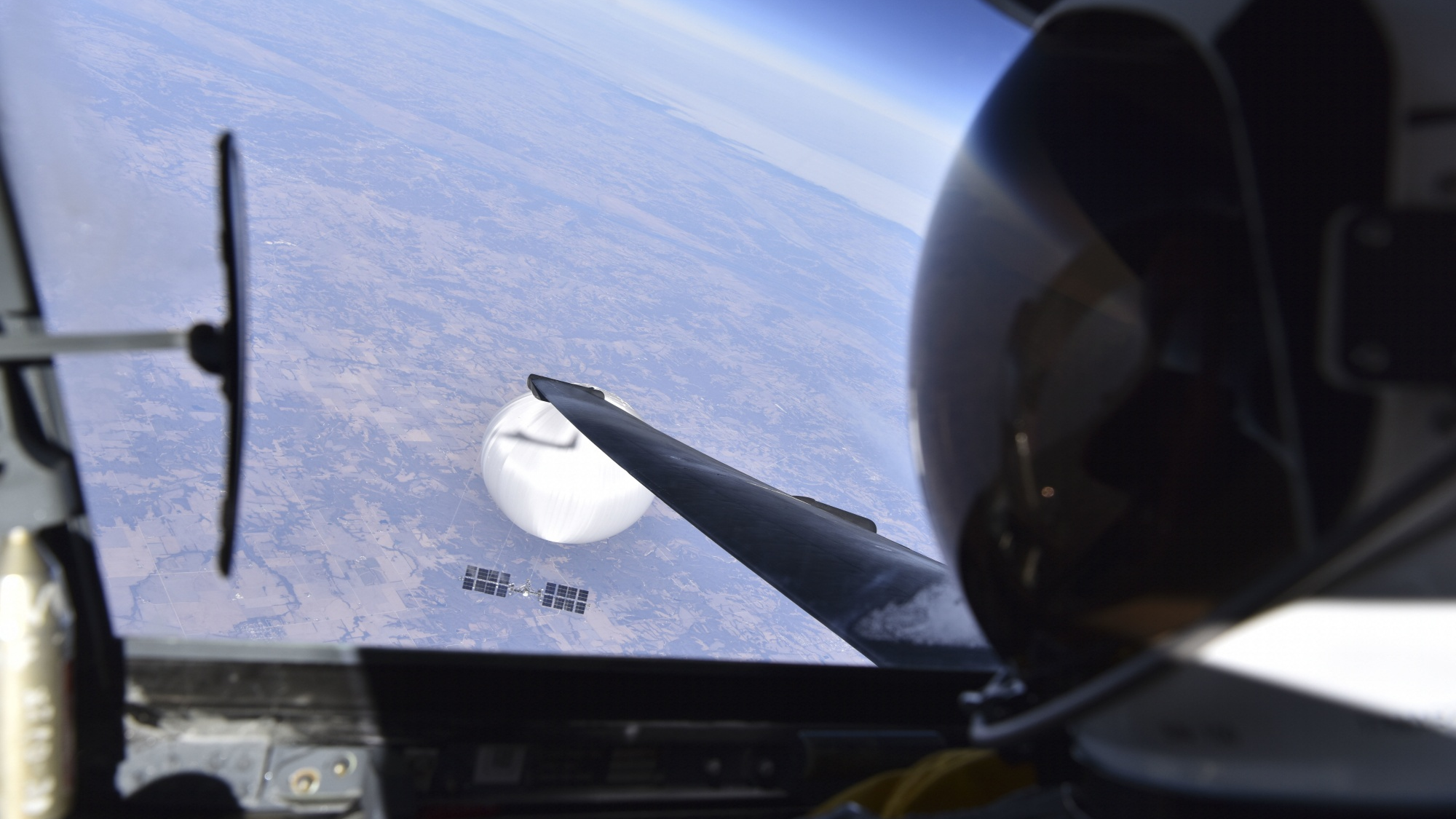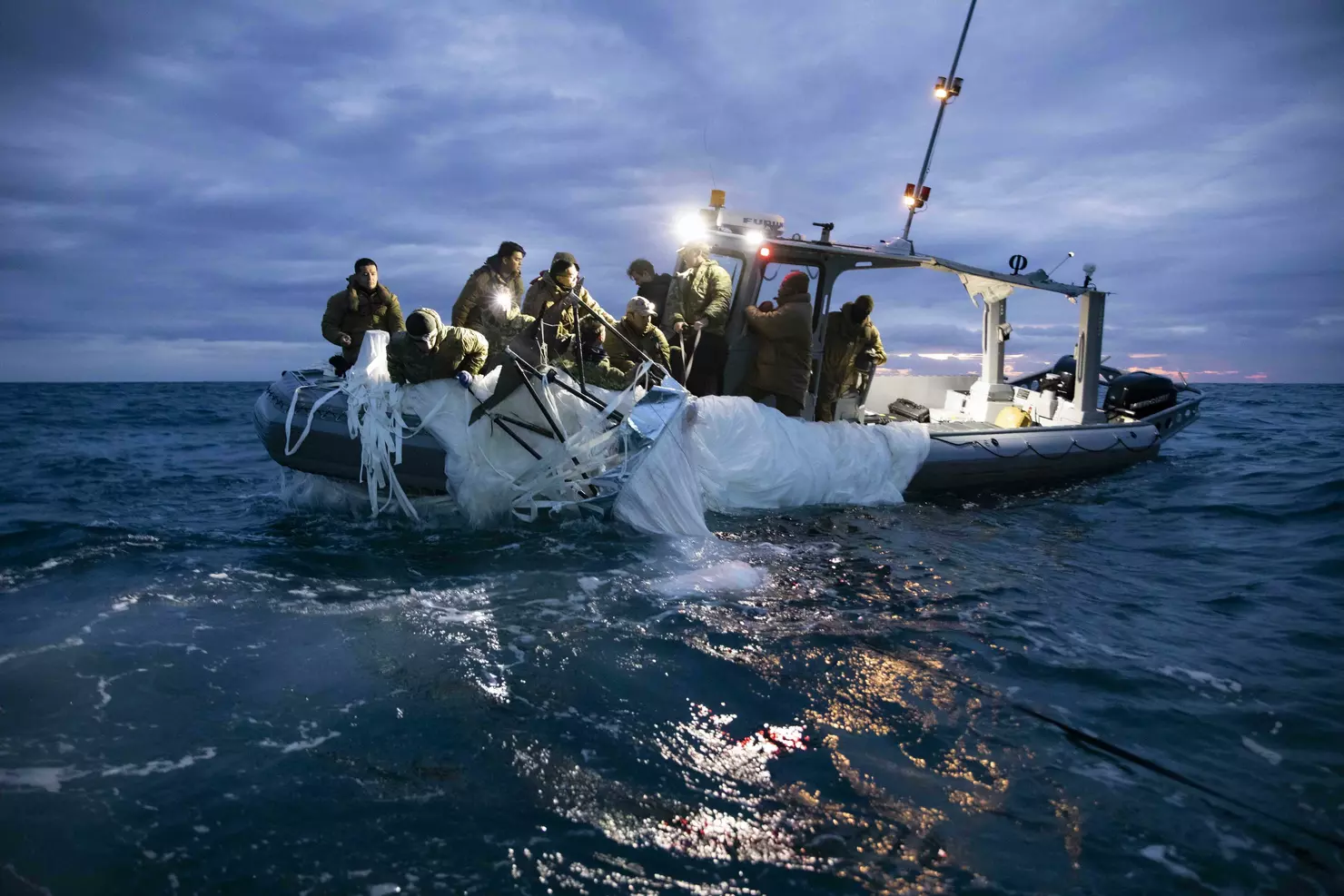
A U.S. Air Force pilot looks down at a Chinese civilian unmanned airship as it hovers over the United States, February 3, 2023. /Getty
A U.S. Air Force pilot looks down at a Chinese civilian unmanned airship as it hovers over the United States, February 3, 2023. /Getty
Editor's note: Zhu Yaochun is the Deputy Secretary General of China Air Transport Association. The article reflects the author's opinions and not necessarily the views of CGTN.
The Pentagon said on April 3 that they couldn't confirm the Chinese civilian unmanned airship, which the U.S. government shot down earlier this year, was able to transmit data back to Beijing in real-time.
According to China's Foreign Ministry, the airship was used for research, mainly meteorological purposes. It was an accident "caused by force majeure" when it drifted into the United States. Affected by the Westerlies and with limited self-steering capability, the airship deviated far from its planned course. For an incident like this, the U.S. should have handled it peacefully and properly in a calm, rational, professional, and restrained manner. Most countries in the world share this attitude and support China's position.
Unfortunately, the indiscriminate use of force by the U.S. against the civilian airship was clearly an overreaction. As Chinese media outlet Global Times has pointed out, such an action of the U.S. was just like "shooting a mosquito with cannon" and wasted taxpayers' money. For a civilian airship, the U.S. dramatically sent in its Air Force F-22 Raptor to shoot it down. Later, the U.S. shot down three more aircraft over northern Alaska, Canada's Yukon Territory, and Lake Huron in Michigan, using missiles that were worth about $400,000 each.
The Northern Illinois Bottlecap Balloon Brigade, an amateur club in Illinois, announced on February 15 that one of its "pico balloons" was "missing in action," Aviation Week reported on its website on February 16. While the club did not make any public accusations, Aviation Week said circumstantial evidence suggested their balloon was likely one of the high-altitude objects previously shot down by the U.S. Air Force. Such a "big fight" was nothing but ridiculous.
When the U.S. Department of Defense already stated that "the balloon does not present a military or physical threat to people on the ground," it was evident that it was neither legal nor reasonable to shoot down a harmless civilian airship. Shooting it down was in serious violation of basic principles of "non-use of force against civil aircraft" and "necessity, proportionality, and the use of force" in international law, including the Convention on International Civil Aviation (CICA).
Article 25 of the CICA provides that "Each contracting State undertakes to provide such measures of assistance to aircraft in distress in its territory as it may find practicable."
The airship was with limited self-steering capability and drifted into the airspace of the U.S. due to force majeure. The U.S. should have "provided measures of assistance as it may find practicable" instead of shooting it down.

Sailors assigned to Explosive Ordnance Disposal Group 2 recover a Chinese civilian unmanned airship off the coast of Myrtle Beach, South Carolina, United States, February 5, 2023. /Getty
Sailors assigned to Explosive Ordnance Disposal Group 2 recover a Chinese civilian unmanned airship off the coast of Myrtle Beach, South Carolina, United States, February 5, 2023. /Getty
However, in spite of repeated statements from China, the U.S. overreacted by insisting on the use of force against the civilian airship that was about to leave U.S. airspace. China Air Transport Association (CATA) has expressed its opposition against U.S.' move.
With the increasing frequency of high-altitude operations around the world, incidents of aircraft accidentally entering the airspace of another country do occur occasionally due to technical failure or force majeure. When it does, it is often handled in a calm, professional, and restrained manner through dialogue, cooperative international communication, and proper management by peaceful means, according to international practice.
In practice, civilian airships accidentally entering a country's airspace are usually dealt with by measures such as warning, repulsion, accompanying flight and forced landing, and such incidents are resolved peacefully through diplomatic channels. According to general international law, in special circumstances such as force majeure, technical failure, or distress, the illegality of unauthorized entry of civilian aircraft into the airspace of another country may be exempted, and appropriate assistance and handling measures shall be taken in this regard.
The Chinese airship shot down by the U.S. was big and visible to discovery. There is no reason for China to use it as a "spy balloon." Related investigation conducted by the U.S. has been hijacked by domestic politics and serves the strategy of containing China.
While doing its best to undermine China, the U.S. has chosen not to talk about its own airships entering China's airspace. According to China's Foreign Ministry spokesman Wang Wenbin, since last year, U.S. high-altitude balloons have flown over Chinese airspace over 10 times without authorization from China, yet the U.S. didn't give an open and transparent response to this.
There have been frequent security problems in the U.S. The Ohio train derailment is a case in point. Another example is the revolving door deal between the U.S. arms industry and politicians, which has continuously emptied the U.S. economy.
The U.S., known as one of the richest countries in the world, has become the most indebted country in the world, with its national debt reaching $31 trillion. The U.S. borrowed money to fight wars abroad, issued debt and printed money, which caused high inflation and threatened people's livelihood. Turning a blind eye to domestic problems while attacking and smearing China has become a common U.S. diversion tactic.
CATA calls for strengthened international cooperation and coordination for unmanned civilian airships in airspace to ensure air traffic safety. Such cooperation is also expected to promote the development of the unmanned civilian airship industry and ensure a better future for mankind.
(If you want to contribute and have specific expertise, please contact us at opinions@cgtn.com. Follow @thouse_opinions on Twitter to discover the latest commentaries in the CGTN Opinion Section.)